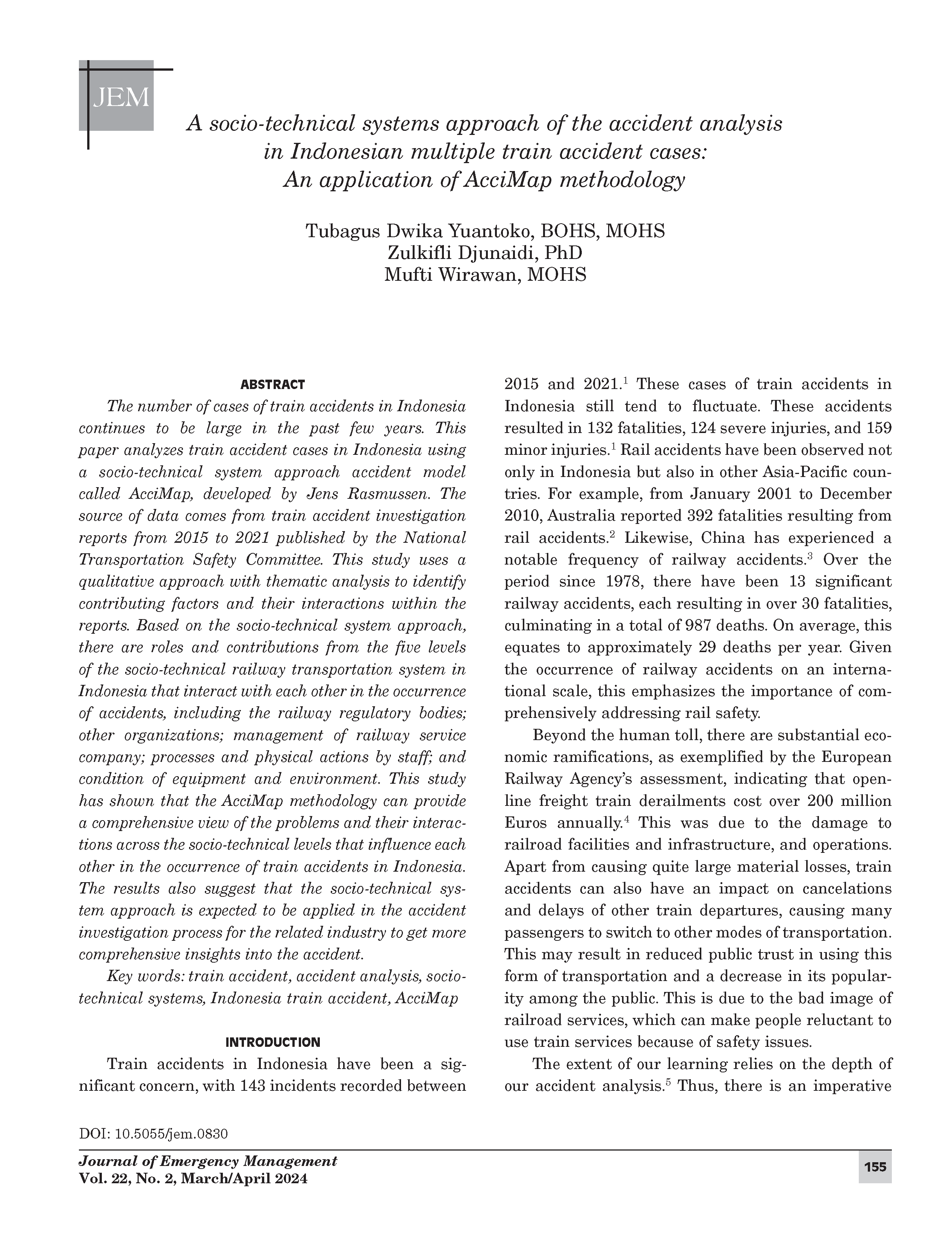A socio-technical systems approach of the accident analysis in Indonesian multiple train accident cases: An application of AcciMap methodology
DOI:
https://doi.org/10.5055/jem.0830Keywords:
train accident, accident analysis, sociotechnical systems, Indonesia train accident, AcciMapAbstract
The number of cases of train accidents in Indonesia continues to be large in the past few years. This paper analyzes train accident cases in Indonesia using a socio-technical system approach accident model called AcciMap, developed by Jens Rasmussen. The source of data comes from train accident investigation reports from 2015 to 2021 published by the National Transportation Safety Committee. This study uses a qualitative approach with thematic analysis to identify contributing factors and their interactions within the reports. Based on the socio-technical system approach, there are roles and contributions from the five levels of the socio-technical railway transportation system in Indonesia that interact with each other in the occurrence of accidents, including the railway regulatory bodies; other organizations; management of railway service company; processes and physical actions by staff; and condition of equipment and environment. This study has shown that the AcciMap methodology can provide a comprehensive view of the problems and their interactions across the socio-technical levels that influence each other in the occurrence of train accidents in Indonesia. The results also suggest that the socio-technical system approach is expected to be applied in the accident investigation process for the related industry to get more comprehensive insights into the accident.
References
Directorate of Traffic and Railways, Ministry of Transportation of the Republic of Indonesia: Railway safety statistics: 2015-2019. 2022. Available at www.djka.dephub.go.id. Accessed March, 20, 2022.
Australian Transportation Safety Bureau: Australian rail safety occurrence data 1 January 2001 to 31 December 2010. 2011. Available at https://www.atsb.gov.au/publications/2011/rr-2011-004. Accessed June, 2, 2023.
Wang D, Zhang T: Engineering accidents in society: A comparison of Chinese and American railway accident investigation. Technol Soc. 2015; 43: 69-74. DOI: https://doi.org/10.1016/j.techsoc.2015.05.011
European Railway Agency (ERA): Study: Impact assessment on the use of derailment detection devices in the EU railway system, ERA/REP/03-2009/SAF. 2009. Available at https://www.era.europa.eu/system/files/2022-10/Agency%E2%80%99s%20final%20report%20on%20the%20%E2%80%9CPrevention%20and%20mitigation%20of%20freight%20train%20derailments%20at%20short%20and%20medium%20terms%E2%80%9D.pdf. Accessed June, 2, 2023.
Fan Y, Li Z, Pei J, et al.: Applying systems thinking approach to accident analysis in China: Case study of “7.23” Yong-Tai-Wen high-speed train accident. Saf Sci. 2015; 76: 190-201. DOI: https://doi.org/10.1016/j.ssci.2015.02.017
Suryoputro MR, Sari AD, Kurnia RD: Preliminary study for modeling train accident in Indonesia using Swiss Cheese Model. Proc Manuf. 2015; 3: 3100-3106. DOI: https://doi.org/10.1016/j.promfg.2015.07.857
Underwood P, Waterson P: Systems thinking, the Swiss Cheese Model and accident analysis: A comparative systemic analysis of the Grayrigg train derailment using the ATSB, AcciMap and STAMP models. Acc Anal Prevent. 2014; 68: 75-94. DOI: https://doi.org/10.1016/j.aap.2013.07.027
Salmon PM, Cornelissen M, Trotter MJ: Systems-based accident analysis methods: A comparison of AcciMap, HFACS, and STAMP. Saf Sci. 2012; 50(4): 1158-1170. DOI: https://doi.org/10.1016/j.ssci.2011.11.009
Newnam S, Goode N: Do not blame the driver: A systems analysis of the causes of road freight crashes. Acci Anal Prevent. 2015; 76: 141-151. DOI: https://doi.org/10.1016/j.aap.2015.01.016
Dekker S: Drift into Failure: From Hunting Broken Components to Understanding Complex Systems. Boca Raton, FL: CRC Press, 2016. DOI: https://doi.org/10.1201/9781315257396
Rasmussen J: Risk management in a dynamic society: A modelling problem. Saf Sci. 1997; 27(2-3): 183-213. DOI: https://doi.org/10.1016/S0925-7535(97)00052-0
Thoroman B, Salmon P, Goode N: Applying AcciMap to test the common cause hypothesis using aviation near misses. Appl Ergon. 2020; 87: 103110. DOI: https://doi.org/10.1016/j.apergo.2020.103110
Zhou W, Zhao T, Liu W, et al.: Tower crane safety on construction sites: A complex sociotechnical system perspective. Saf Sci. 2018; 109: 95-108. DOI: https://doi.org/10.1016/j.ssci.2018.05.001
Lee S, Moh YB, Tabibzadeh M, et al.: Applying the AcciMap methodology to investigate the tragic Sewol ferry accident in South Korea. Appl Ergon. 2017; 59: 517-525. DOI: https://doi.org/10.1016/j.apergo.2016.07.013
Qureshi ZH: A review of accident modelling approaches for complex critical sociotechnical systems. Defence Science and Technology Organisation, Australia. 2008. Available at https://apps.dtic.mil/sti/pdfs/ADA482543.pdf. Accessed March, 5, 2022.
Salmon PM, Read GJ, Stanton NA, et al.: The crash at Kerang: Investigating systemic and psychological factors leading to unintentional non-compliance at rail level crossings. Acc Anal Prevent. 2013; 50: 1278-1288. DOI: https://doi.org/10.1016/j.aap.2012.09.029
Salmon PM, Goode N, Archer F, et al.: A systems approach to examining disaster response: Using AcciMap to describe the factors influencing bushfire response. Saf Sci. 2014; 70: 114-122. DOI: https://doi.org/10.1016/j.ssci.2014.05.003
Hamim OF, Hoque MS, McIlroy RC, et al.: Applying the AcciMap methodology to investigate the tragic Mirsharai road accident in Bangladesh. MATEC Web Conf. 2019; 277: 02019. DOI: https://doi.org/10.1051/matecconf/201927702019
Chen L, Zhao Y, Zhao T: An AcciMap analysis on the China- Yongwen railway accident. In Engineering Asset Management-Systems, Professional Practices and Certification. Cham: Springer, 2015: 1247-1253. DOI: https://doi.org/10.1007/978-3-319-09507-3_105
Leveson N: A new accident model for engineering safer systems. Saf Sci. 2004; 42(4): 237-270. DOI: https://doi.org/10.1016/S0925-7535(03)00047-X
Reason J: Human Error. Cambridge: Cambridge University Press, 1990.
Svedung I, Rasmussen J: Graphic representation of accident scenarios: Mapping system structure and the causation of accidents. Saf Sci. 2002; 40: 397-417. DOI: https://doi.org/10.1016/S0925-7535(00)00036-9
Salmon PM, Lenné MG: Miles away or just around the corner? Systems thinking in road safety research and practice. Acc Anal Prevent. 2015; 74: 243-249. DOI: https://doi.org/10.1016/j.aap.2014.08.001
Goode N, Salmon PM, Taylor NZ, et al.: Developing a contributing factor classification scheme for Rasmussen’s AcciMap: Reliability and validity evaluation. Appl Ergon. 2017; 64: 14-26. DOI: https://doi.org/10.1016/j.apergo.2017.04.014
Stevens NJ, Salmon PM: Sand, surf and sideways: A systems analysis of beaches as complex roadway environments. Saf Sci. 2016; 85: 152-162. DOI: https://doi.org/10.1016/j.ssci.2016.01.009

Downloads
Published
How to Cite
Issue
Section
License
Copyright 2007-2025, Weston Medical Publishing, LLC and Journal of Emergency Management. All Rights Reserved.
Leave Nobody Behind: Emergency Management in a More Inclusive Way is a trademark of Journal of Emergency Management





